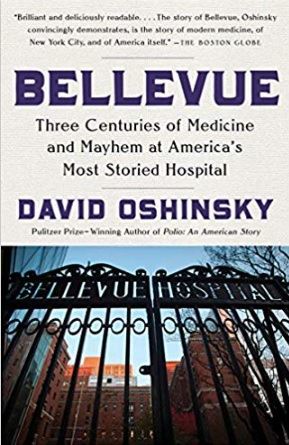 Founded in 1980 |
|
| David Oshinsky, Bellevue: Three Centuries of Medicine and Mayhem at America’s Most Storied Hospital, New York: Anchor Books, a Division of Penguin Random House LLC, 2016. ISBN 978-0-307-38671-7. |
Reviewer: Alan Lippman, MD
April 18, 2018
The character of New York City’s Bellevue Hospital has been described as complex, controversial, monumental, and unique. Clearly reflecting the historical saga of its host city, this quintessential institution, established in the late seventeenth century as a simple—and dreadful— almshouse, has evolved, over the past three centuries, into what can arguably be called one of today’s indispensable public hospitals and premier trauma centers. It was the first American hospital to have a maternity ward, an ambulance corps, and a nursing school (for women only!) Its innumerable patients have included the famous and the infamous—from Eugene O’Neill and Norman Mailer to Mark David Chapman and the “Son of Sam.” Bellevue has been regarded as a pioneering institution for the care of the poor and destitute and those afflicted by infectious disorders, from epidemic typhus in the 1840s through AIDS in the 1980s.
David Oshinsky, recipient of a Pulitzer Prize in History for Polio—an American Story, here provides a stunning and captivating chronicle of this landmark institution, whose history clearly reflects the growth and maturity of American medicine. As a New York University professor and Director of the Division of Medical Humanities at the NYU School of Medicine, Oshinsky is well-positioned to offer knowledgeable and meaningful insights that result in a compellingly readable book.
Bellevue originally played a meaningful supportive role in medical education, not only in its collaboration with New York City’s multiple medical schools, but in 1861 established—amid controversy—its own medical college. Bellevue’s reputation was enhanced, in 1956, with the award of a Nobel Prize in Medicine to Andre Cournand and Dickinson Richards for their establishment of cardiac catheterization as an essential tool in diagnostic cardiology. Contrastingly, its work in the care of those having mental disorders—erstwhile referred to as “lunatics”—was perhaps sullied by the tendentious practices of shock therapy and administration of drugs like LSD to autistic children.
In recent years, the institution’s memorable achievements—and even its continued very existence—have been threatened by the social ills of crime and drug addiction, the growing costs of hospital care, competition from private, better-insured medical centers, fiscal uncertainties, and natural disasters such as Hurricane Sandy. Yet, the institution has played a heroic role treating first responders to the events of 9/11 and dealing with some of the victims of Ebola.
Replete with exquisite detail and colorful anecdotes, Oshinsky’s book makes for delightful reading.
